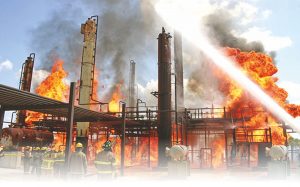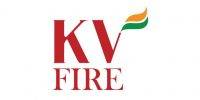 The consequences of a major industrial fire can be catastrophic, potentially impacting on the business' ability to survive, workforce safety and employment, the local environment and the surrounding community.
The consequences of a major industrial fire can be catastrophic, potentially impacting on the business' ability to survive, workforce safety and employment, the local environment and the surrounding community.
Industrial premises come in a wide variety of shapes and sizes and cover everything from the smallest traditional engineering workshop to the latest cutting-edge, hi-tech production facility. They can range from a relatively low fire load, low risk one-man operation to the massive high-hazard chemical and petrochemical complex. Some have a fast turnaround of goods with little inventory, while others demand the storage of highly flammable fuel, raw materials and finished goods. Not all operate within the conventional nine-to-five timeframe; some are in action around the clock whereas others have automatic machinery that is in unmanned “lights out” operation. Even the fire load can vary in some industrial premises, particularly those involved in manufacturing and storing seasonal goods.
If that is not enough to contend with, while industrial buildings around the world have been constructed to comply with a variety of building codes and standards, older buildings that were constructed long before today's regulations and codes of practice are still commonplace in many countries. The result is that industrial buildings can still be found that are built to less stringent standards than those in force today, with a degree of fire protection, compartmentation, fire stopping, fire detection and fire suppression that would be unacceptable in industrial premises built today. They frequently also utilize materials that are no longer acceptable. This includes asbestos and cladding and lining materials with unacceptable spread of flame or other fire performance characteristics.
The problems associated with these older industrial buildings are compounded by three other factors. Many are now used for purposes other than those originally intended, and possibly without approval for their change of use; they may well contain substantially different fire loadings and risks than were originally anticipated; and may now have environmental or neighbouring challenges that did not exist when the premises were originally built.
Manufacturing, assembling and warehousing are today highly automated operations where the philosophy is often to achieve the maximum stockholding in the minimum space; to make every square metre of space earn its keep. High-level – sometimes floor the ceiling – racking and access gangways so narrow that fork-lift trucks and side loaders completely block the gangway are the norm.
Companies involved in the manufacture or distribution of seasonal or fast-turnaround stock run the risk of using every conceivable space for storage without sufficiently considering the implications for the safe evacuation of employees in a fire, or the safety of the emergency services tackling a blaze as a result of blocked access or evacuation routes. Storage can also be allowed to spill over into adjoining areas during periods of peak demand, utilizing forecourts, yards and loading bays.
But, it is not just the increased density of goods that needs to be assessed. Attention also needs to be paid to the fire load characteristics of the stored goods. For example, highly flammable plastic shrink wrapping is now in widespread use, as is highly combustible cardboard and plastic packaging materials and plastic pallets.
These raise the question of fire risk assessments for industrial premises. While the need for them should by now be widely understood, the importance of treating them as an on-going activity may not be sufficiently appreciated by industry. Fire strategies for industrial premises need to be particularly robust and reliable, and the reality of the situation is that in industrial buildings where the volume of stock and its location change on a daily basis, a fire risk assessment needs to be undertaken at a matching frequency.
Empty building risk
The building owners' responsibilities are not removed by virtue of the building being unused or unoccupied. Even if the building is properly decommissioned and mothballed; the owner or occupier still has responsibility for the maintenance of fire detection and alarm systems or fire suppression installations in as far as they safeguard maintenance or security personnel, or impact on the safety of firefighters who may be called upon to tackle a blaze in the empty building. Very careful thought has to be given to fire safety precautions before shutting down existing fire detection and firefighting installations or cancelling maintenance regimes. Empty premises are also particularly prone to vandalism and arson, so effective security needs to be implemented to make sure that essential fire safety equipment has not been maliciously damaged or even stolen.
Neighbourhood assessment
Particularly in older premises, a fire can easily spread to adjoining premises, due to the poorer fire performance of the materials used for its construction or the closeness of neighbouring buildings. So, there is a strong argument for co-operating with the management of nearby industrial units to exchange information on fire safety precautions, potential fire risks, preventative measures and fire risk assessments. Adopting an integrated and coordinated approach with neighbouring sites, and sharing that information with the local emergency services may well pay huge dividends in the event of a fire.
Whomever is responsible for undertaking the fire risk assessment, it is imperative that he or she has an intimate understanding of the special risks associated with industrial buildings in general and of the specific material, production and process risks and challenges of the particular site. These risk assessments must be carried out and regularly updated by competent specialists who can demonstrate experience in these often volatile and special high-hazard environments.
Risk assessments for any high-risk industrial site – particularly if it uses toxic, highly flammable or explosive substances – should not be limited to what might be described as “internal” fire safety threats and challenges. For instance, the responsible assessor needs to take into account what is going on beyond the site's perimeter fence that might pose a fire risk: what spill-over risks do neighbouring properties and their processes pose, and how can these be negated.
The type and complexity of the fire detection and alarm system and the provision of fixed fire suppression equipment will naturally vary from site to site, depending on many factors. Certainly, there is no shortage of reliable solutions on the market that adhere to the latest standards and codes of practice.
However when considering larger, more business critical or high risk industrial sites it is wise not to fall into the trap of believing that detection, alarm and suppression are all that need to concern the building owner. Frequently there is much more that needs to be considered. After all, the objective is to minimize the impact of a fire, and that may well mean not assuming that your responsibilities end with the arrival of the emergency services. The resources that are essential for the fire and rescue service need to be available at a moment's notice. One example is fire hydrants. Not only do they need to be in the right places, the pressure at each hydrant needs to be tested regularly.
Testing of fire preparedness in industrial premises is not merely a matter of routine maintenance of the detection and alarm system or the fire suppression equipment; it should embrace every aspect of the emergency and evacuation arrangements in as close to a real-life or worse-case scenario as possible. The reality of the situation is that, while you may only ever have one fire, it may turn out to be the organization's last. The statistics on business closures following a fire make sobering reading, and the life and property stakes are too high in these high risk environments to leave anything to chance.
Fires and explosions needlessly kill and injure employees and damage billions of dollars worth of property and goods every year. Here are steps you can take to keep your business from going up in smoke.
William Fries admits he was shocked. Fries, director, property services, Loss Prevention Department, Liberty Mutual Group, thought he had seen and heard it all during his time with the company, but this was a new one. During a routine inspection, he asked a safety director at a pulp and paper mill if it had a frequency problem with fires. He was relieved to hear that the company had never had a big fire.
His happiness was short-lived as the safety director went on to explain that once a week, a certain machine would cause a dust explosion, a small flash fire. The safety director tried to reassure Fries, telling him that the vigilant machine operator had a garden hose standing by and he “takes care of it.”
“What if the operator was on break? What if he went to lunch or the bathroom when the flash fire occurred? That small controllable fire could take the entire plant down,” said Fries, his voice rising with disbelief. “Those kinds of stories really shake me up.”
Experts agree that there is no such beast as a fireproof facility. Too many elements are involved to make those kinds of claims. A host of factors — building design and materials, machinery, wiring, fire suppression systems, emergency response programs, alarm systems, inspection and testing of fire response equipment and systems, chemicals on site, training, housekeeping, end products — can work alone or combine to impact on fire resistance and prevention. But there are a number of ways, said Fries, to avoid courting disaster like the safety director at the pulp and paper mill.
Protection and Prevention
Protection ensures that a small containable fire in a trash can, for example does not turn into a catastrophic event which can devastate a business, the lives of workers and a community. Prevention ensures that the trash can fire does not ignite in the first place.
Fries cites one example of such an event: An electric eraser used by drafters at one company was stored in such a way that the nose of the eraser pressed against the side of the drawer. The contact caused the eraser to switch on and vibrate. The constant friction caused the eraser to overheat and start a fire which spread throughout the room, fueled by the stacks of papers and plans used by the drafters.
“If that eraser had been properly stored, that fire would never have occurred,” noted Fries. “Fires usually start small. Processes become so familiar that the workers lose respect for them, become a little bit careless, and that's all it takes.”
The answer, said Fries, is prevention. Experts focus on several aspects of prevention — good housekeeping, good work habits, employee training and workplace inspection — as ways to avoid minor events and major catastrophes. According to figures from Factory Mutual, three-fifths of fires and nearly three-fourths of property damage could be avoided through preventive maintenance and frequent inspection and testing of equipment and electrical systems; taking proper safety precautions during maintenance operations; and using caution around open flames.
“Many of the fires we've responded to were due to inadequate work practices — such as cutting and welding operations without a fire watch [keeping a close watch on an area in which hot work has been conducted for several hours after the work has been completed]. Others were at areas which weren't cleaned up, did not have flammables and combustibles properly stored or had grease or oil-soaked floors,” said Scott Dornen, a fire chief at Atlantic Richfield Co.'s (ARCO) Prudhoe Bay, Alaska, facility and a member of the International Association of Fire Chiefs.
According to Dornen, such incidents at his location have declined in recent years due to several factors. At the height of construction on the Alaska pipeline, ARCO had as many as 120 contractor companies on site, all with different safety policies and procedures. Many of those companies are gone, and with less construction and fewer operations and employees, the opportunities for fires and explosions have diminished.
He added that many of the companies with which ARCO now contracts have improved their maintenance, inspection and housekeeping, in part because of the high standards ARCO maintains for its own operations. For example, before new facilities are constructed at ARCO or a new process undertaken, the building plans go through an extensive design review which includes the use of a 1-to-24 inch scale model. All engineering controls to prevent and protect against fire and explosion are examined.
Dornen helps review the layout of fixed protection, such as sprinkler and alarm systems, to make sure it is more than adequate to meet the challenges of the operations planned for that facility. The scale models help Dornen and the safety department, with whom he closely works, look for things like blocked emergency exits, dead-end aisles and walkways, locations of storage areas for chemicals and inventory which are away from potential ignition sources, and emergency escape routes. Through the use of such models, they can also examine the placement of fire walls and doors to make sure that fires can be contained in specific areas.
Building in Fire Safety
In addition to planning fire safety into the design of new facilities and processes, experts suggest a close evaluation of the materials used to construct new buildings and/or maintain older ones. Determining the fire protection factors for buildings and materials can seem daunting, but James Martin, a property team leader with the Loss Control Group, ITT Hartford Group, notes that many business insurers are willing to advise their clients about fire prevention and protection.
He offers up this list of questions that safety professionals, building engineers and emergency response personnel need to be able to answer about their workplace:
What are the structural building materials?
Are the walls, ceilings and floors, furniture, floor coverings and window treatments fire-resistant?
Do they meet or exceed current NFPA, Underwriters Laboratories and industry standards, as well as state and federal codes?
Are the fire suppression systems adequate to meet the needs of the facility and the potential hazards?
Is the local water supply adequate to meet the needs of the sprinkler system and emergency responders?
He said that alarm systems should be hooked up to emergency generators as well as the central power source. It's not inconceivable that in a fire or other emergency situation, the main electrical system would shut down. He also suggested using extreme caution when conducting maintenance operations which involve drilling holes in ceilings and floors. Any pipe chases which travel between floors must be properly sealed with a fire retardant material. Otherwise, they provide a perfect opportunity for a fire to jump from floor to floor and engulf an entire building.
Finally, said Martin, get upper management involved and proactive about fire safety. If management focuses attention and resources on fire prevention and proactive maintenance, employees will understand that fire safety, good maintenance and housekeeping are important parts of their jobs.




















































